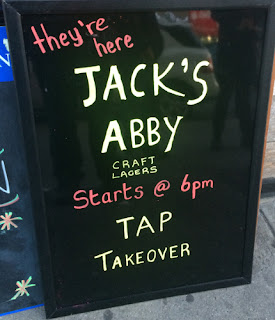 |
| Co-owner Graham, center, surrounded by beer reps. Shane from Sly Fox on the right. |
 Non-Flash version of the podcast
Non-Flash version of the podcastAt first blush, "self service beer bar" sounds like a cheeky gimmick, and we weren't sure what to expect when we visited the Lower East Side's Paloma Rocket, located at 7 Clinton Street, just below Houston. Opening recently with 30 taps pouring a respectable list of craft beers, all but four domestic and with heavy representation of NY State breweries, was this just a clever way to stand out from the other craft beer joints dotting the downtown bar scene?
Maybe... but maybe not. Let's first explain what it's all about and how it works before further contemplation on the subject.
 |
| Paloma Rocket could be the name of sultry, kick-ass "Bond Girl". Stay at the bar long enough and you may have a very Mary Goodnight! |
First off, in order to get the beer flowing, you'll need an RFID card -- you get that at the horseshoe shaped bar to the right as you enter Paloma Rocket. You can put whatever dollar amount that you like onto the credit card sized plastic card -- $20 seems to be the average. Each of the 30 taps that line the back wall has a display screen with information about the beer that pours from that tap: brewery name and logo, some info on the brewery, perhaps, name and style of the beer, a brief description of the beer. You can scroll down the touch screen and see the ABV, for example. There is a place above the tap to set your "beer card" to active the tap.
 |
| B.R., aka Beer Rocket, can pour her own beer, thank you very much! |
When you place the card above the tap, the video screen displays the value/balance on your card and the price per ounce of that particular beer. Prices range from 50-cents to $1.50 an ounce, and can be as high as $4 per ounce for a rare, high-ABV, exclusive brew. Next you select one of many styles of glassware stored on a shelf above the taps, give it a rinse with the upward-spraying rinsers set into the drip tray below, and you're ready to pour your own beer!
 |
| Don't forget to tip yourself! |
As you pour, you see the ounces tick up (similar to a gas pump or fro-yo display) and your card balance tick down as the beer flows into your glass. You can pour as much or as little as you prefer from any tap. Want to get a one-ounce taste of an unfamiliar beer before deciding to go for a full pour? Done, and done! And if you're not sure how to properly pour a pint, Paloma Rocket's staff is there to give a hand.
The beer cards must be returned before leaving the bar -- they expire in 12 hours after purchase. If there is a balance on the card when you leave, the amount will be refunded to you. As Kenny, one of the owners, noted, "it's probably the only bar where you get money back when you leave!"
The absence of a bartender to pour your beer has its ups and downs. Though there's always a "bartender" there to add value on to your card, answer questions, and help suggest pouring techniques, it's obviously not the same as having Isaac mix you a daiquiri while giving you tips on finding love, or some Irish brogue crooning lad or lass charm you. The design and layout of the bar -- huge windows, very open, bright, clean, sparse -- lends itself to a bring-your-own-vibe feel. Large flatscreen TVs are there to ogle, showing soccer, hockey, or whatever other sports happen to be on. (Co-owner Graham is a proud ex-pat Londoner, so proper football is often on screen.)
But there are plenty of benefits to this new system, unique in NYC at the moment. You'll never have to wait to get your glass filled (unless there's a run on something on a crowded night, I suppose). Being able to pour any amount is a definite plus. It's conceivable that one could sample all 30 taps with 1 ounce pours, and still be able to leave without stumbling. Then there's the possibility of "beer blending" -- say, mix some Central Waters Nitro Puppy Porter with some Rodenbach Grand Cru Flanders Red? (Which was possible at the time of this posting.)
Clearly, this is not your wood paneled, sawdust floor, dark, worn in, 100-year-old oak bar, and it's not your hip, beer nerd/beer snob, $10-per-8oz-pour, served by your beer sommelier bar. It is a place where you can go learn about beer on your own, if you care to, try as much or little as you like of any of 30 beers, pour your own as you like it -- but hopefully not drink alone! It does have the feel of a sort of "beer arcade" where you can play bartender, which makes for a fun destination for a party. After riding the Paloma Rocket ourselves, we know that, while it might not suit everyone's orbit, we had fun, enjoyed some very good beers, and we'll definitely book many future flights!
 |
| Kenny demonstrates the system. |
 |
| Bob rinses and pours. |
 |
| NY State in the house. Oh, and Vermont. |















































